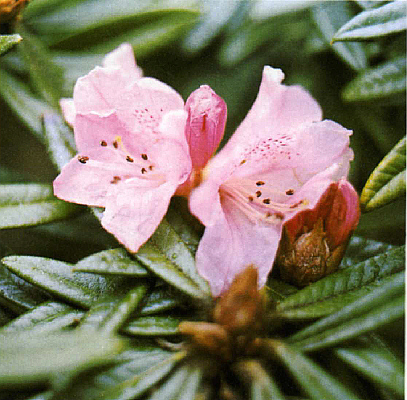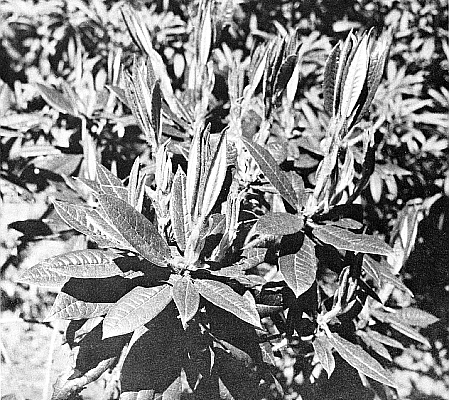Where Have All the Species Gone
D. W. Johnson, Issaquah, Washington
Nearly all of the several thousand named hybrids offer testimony to the dangers of inflorescence fixation, that hypnotic fortnight display of truss, color and blotch which fades into 50 dull weeks of green uniformity. We need to remember that the hybrids, those products of human pride, cannot outperform nature's species if we consider the entire year. For those of us who live in a benign climate, there is no reason why our gardens should be devoid of fragrant inflorescence and rich character in new growth, foliage and bark. If your rhododendrons fail to enchant you most of the year, then try some of nature's spell-binding species.
The species represent a rather delicate and refined orchestration of rhododendron characteristics which, when hybridized, often result in the emphasis of one trait at the expense of another. Quite often the result is a disproportionate, spectacular inflorescence accompanied by foliage with character wrung out. Many charming personalities of the species are genetically recessive and become lost in the hybridization shuffle. The following is a brief suggestion of species whose merits qualify them for consideration in your garden plans.
Fragrance is not common in the species and less so in the hybrids; how many unsuspecting friends lean forward to inhale a scentless flower and, disappointed, move on. Fragrance is expected and sorely missed too often. For those who have the room, the July-flowering R. discolor is a must. Its white or pale pink, 4-inch diameter scented blossoms should be in most gardens. If you cannot provide room for its broad, 15-foot height, perhaps
R. johnstoneanum's
broad 6-foot stature can be accommodated. Although less hardy,
R. johnstoneanum
is far more fragrant and will pervade your garden with a delicious scent in late April.
The thought of aromatic foliage conjures up a vision of steaming medicinal brews carefully stirred to potency by a grey-haired, warty-nosed enchantress. Where rhododendrons are involved, don't drink, just touch. It's great fun to explore the Anthopogon Series. Among its members you will meet some strange personalities indeed. Perhaps the most interesting is little
R. kongboense
. It produces rose-colored flowers as early as March and is hardy to -5 degrees F. In the Cinnabarinum Series, the yellow-apricot flowered
R. concatenans
should not be overlooked. Its lovely blue new foliage is rewarding enough, but if you fail to shake hands with this species, you cannot claim to know it.
R. caesium
in the Triflorum Series also displays yellow flowers and shares with
R. concatenans
an aromatic foliage whose new color is quite blue. Both species are hardy to +5 degrees F. and reach a height of about 6 feet.
Many species produce fascinating new growth. When
R. auriculatum
's new 12-inch leaves emerge from rich, pink ribbon-like bracts, they are an unusual grey-green color covered with soft, furry hairs. Moreover, this new growth follows its unusually late July and August flowering of fragrant white blooms. A broad-topped, 15-foot tree, R. auriculatum is hardy to -5 degrees F. One of the most stunning performers is
R. campanulatum
var.
aeruginosum
. Although its flowers will not win show ribbons, it more than apologizes by producing young leaves of a striking metallic shade of blue which emerge from glistening white sheaths. This species grows to a height of 8 feet and is hardy to +5 degrees F. A real jewel in any garden is
R. recurvoides
of the remarkable Taliense Series. The new pubescent foliage is held erect with the leaf undersurface stark white framed by the apple-green, recurved margins. This is displayed against the background of mature dark green foliage whose thick, cinnamon brown indumentum peeks out here and there from the densely compact 5-foot shrub. R. recurvoides is hardy to + 5 degrees F. and no doubt would be more frequently seen if only it were not so difficult to propagate.

|
|
R. recurvoides
Photo by D. W. Johnson |

|
|
R. crinigerum
Rock #38
Photo by Carl Phetteplace, M.D. |
Since most of the year we see foliage, not the flower which first excited our possessive desires, it is important to assess a plant's foliage and growth habit apart from its inflorescence. Imagine pedicels and branchlets festooned with stout bristles, deeply veined 7-inch oblanceolate leaves a lustrous metallic green on the upper surface and coated beneath with felty, fawn indumentum. The white, flushed rose flowers are massed in a racemose umbel of twelve. This species is
R. crinigerum
, a 12-foot tall member of the Barbatum Series, hardy to -15 degrees F. The Falconers and Grande Series contain many species with fantastic foliage, although, unfortunately, several are just not hardy enough for general consideration. Nevertheless,
R. macabeanum
, hardy to + 5 degrees F., cannot be omitted. In March, it blossoms forth with beautiful yellow trusses of about 25 flowers. Then follows the fabulous silvery, blue-green leaves whose upper surface, dusted with white indumentum, betrays the soft woolly-white indumentum underneath. The mature foliage is strongly veined and reaches a length of 1 2 inches.
R. macabeanum
becomes a broad-topped, well-clothed 15-foot tree. A much smaller but no less superb species is
R. haematodes
. Its leathery, dark green leaves are clothed below with a woolly, cinnamon-brown indumentum which extends past the pedicels onto the branchlets. This symmetrical, 4-foot high member of the Neriiflorum Series will withstand temperatures down to +5 degrees F. Another species having extraordinary foliage is
R. bureavii
. It forms a dense mound, 6 feet or more in height, richly clothed with thick, dark green ovate leaves having a wonderful rusty-red, woolly indumentum. This member of the Taliense Series is hardy to -1 5 degrees F.
Many members of the Ponticum Series possess excellent foliage, but
R. yakushimanum
is foremost. Although it is familiar to many, this species merits even greater use. The leaves, petioles and branchlets are coated with a woolly indumentum which, cream-colored when young, passes through all the delicate shades of warm tans and light browns to reach a mature shade of chestnut brown. The young leaves are at first densely coated on top with indumentum which later appears as a moderate dusting atop the dark green recurved leaves.
R. yakushimanum
forms a dense, 4-foot high mound hardy to -15 degrees F.
Just as there is a wide range in indumentum coloration, there is also a host of different leaf colors to choose from. That off-season green uniformity seen too often in gardens is inexcusable. For a change, consider the pubescent foliage of
R. lepidostylum
. It is probably the bluest in the genus. This species forms a dense, very broad, 3-foot high mound and is hardy to +5 degrees F. Another species with absolutely stunning foliage is
R. pronum
. It wraps itself in rich, dark, blue-green leathery leaves. Although it is a rare plant in commerce, every effort should be made to obtain this member of the Taliense Series. In the fall, the deciduous members of the genus treat us to more color.
R. lutescens
flowers very early in the spring and returns to perform an encore in the fall when its foliage turns yellow and bronze.
R. schlippenbachii
behaves like a New England maple after the first real frost of the season.
R. schlippenbachii
also helps add interest to our gardens during the winter months. Its grey, craggy bark and irregular branching habit can resemble a miniature spreading oak tree. Within the genus, the opposite in bark color and texture can be seen on
R. brachyanthum
's chestnut brown, smooth branches.
In this short article, it is impossible to offer more than a hint of the charms the species display in their sustained, enchanting performance. It is hoped that you will be motivated to take a second look at the rhododendrons you live with. Perhaps, in this age of detente, you should make friends with some of the Chinese members of the. genus.